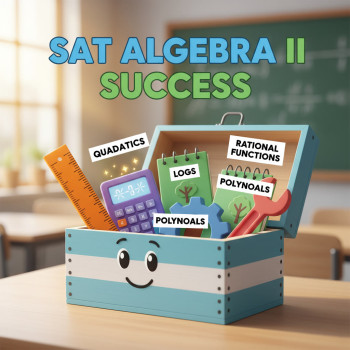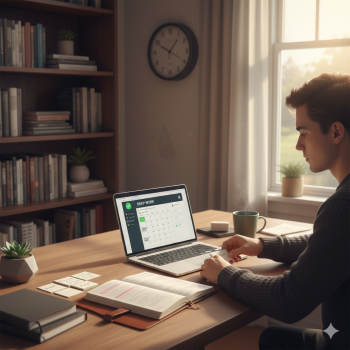Why food on SAT test day matters more than you think
The Digital SAT is more than a test of knowledge — it’s a test of focus, stamina, and how well your brain performs under time pressure. Whatever you ate (or didn’t) that morning will influence how you think, how steady your energy is, and whether your concentration drifts during a long passage or a tricky math problem. Eating well is not about extreme diets or last-minute superfoods. It’s about practical choices that help steady blood sugar, prevent stomach distractions, and keep your mind sharp.

Top principles for SAT test day eating
Before we get into specific snack ideas and timing, keep these six simple principles in mind. They’ll guide your choices and make decisions on a busy morning much easier.
- Choose steady energy over quick sugar spikes. Foods that release energy gradually (complex carbs + protein or healthy fat) keep focus longer than candy or sugary drinks that crash you an hour later.
- Stick with familiar foods. Test day is not the time to experiment with spicy, greasy, or exotic dishes that might upset your stomach.
- Hydrate strategically. Water is your friend, but avoid overdrinking right before the test to limit bathroom interruptions.
- Plan for your break(s). Use the official break window(s) to refuel — you’ll get the most benefit from a well-timed snack halfway through long testing sessions.
- Pack accessible, allowed items. You can keep snacks out of sight during testing and eat them only during breaks. Know what proctors provide and what the test center permits.
- Consider allergies and accommodations. If you have food allergies or special dietary needs, plan ahead (and inform proctors if you need safe storage for medicine like an EpiPen).
What the test center allows (practical rules)
You’ll want to be aware of what’s permitted at the testing center. For the Digital SAT, the testing organization allows students to bring a drink and snacks for breaks — but not to have them on the desk during testing. Scratch paper is provided, and electronics like phones and headphones are generally prohibited unless you have an approved accommodation. In short: bring snacks, but keep them packed and ready for the scheduled break.
Morning meal: timing and meal ideas
Your breakfast sets the tone. Avoid skipping breakfast — studies and common experience show that students who eat a balanced breakfast perform better on attention and memory tasks.
When to eat
- Avoid a huge meal right before the test. Eat 60–90 minutes before test start to allow digestion and reduce the chance of sluggishness or needing the restroom.
- If your test starts early, have a light but balanced meal. If you wake up very early, split your breakfast into a small meal before leaving and a more substantial snack to eat on arrival (during the allowed pre-test holding period or during the break).
Breakfast ideas that work
- Greek yogurt with berries and a sprinkle of granola (protein + fiber).
- Oatmeal with banana and a spoonful of peanut butter (complex carbs + healthy fat).
- A whole-grain toast with avocado and a hard-boiled egg (balanced and not heavy).
- Smoothie with milk or a dairy-free alternative, spinach, banana, and a scoop of protein powder — easy to digest if you’re nervous.
Snacks to pack for the official break
Think small, portable, and resilient to sitting in a backpack. The goal is to re-up your energy without weighing you down.
- Fresh fruit that’s travel-friendly: banana, apple, or clementines.
- Trail mix with nuts and dried fruit (not too salty).
- Protein or granola bars with minimal added sugar.
- Rice cakes with almond butter packets.
- String cheese or small portioned cheese if you can keep it cool — some students put it in a small insulated pack.
Snack timing strategy
If your Digital SAT administration includes a mid-test break, plan to eat a small snack 5–10 minutes into the break to allow a few minutes for digestion or to calm nerves. Use the remaining break time to hydrate and reset mentally — don’t cram more studying into the break; instead, breathe, stretch, and avoid screens if possible.
What to avoid
It’s tempting to grab candy or energy drinks for a quick jolt. Resist those on test day.
- Avoid sugary sodas, energy drinks, or excessive caffeine — they create quick spikes and then crashes, plus they can increase nerves.
- Avoid greasy, heavy, or extremely spicy foods that can cause indigestion.
- Avoid trying new supplements or diet fads on test day.
Hydration: how much and when
Hydration helps cognitive performance, but timing matters. Drink a steady amount of water leading up to the test. Aim for 12–20 ounces in the two hours before the test and a small sip just before the proctors check in. During the break, have another 8–12 ounces. Avoid guzzling right before testing starts to reduce restroom trips.
Simple packing checklist for the night before
Lay everything out so morning stress doesn’t make you forget the small but important things.
- Clear, resealable bag with break snacks (label if you have allergies).
- Water bottle (empty if your center asks you to fill it after check-in) — a reusable bottle is more eco-friendly and familiar.
- Backup breakfast or snack in case of travel delays (granola bar, banana).
- Any required medication (in a clear bag if requested by the center) and a note about allergies if needed.
- Admission ticket, ID (if required), charger or spare battery for the allowed testing device, and a small watch without audible alarm.
Quick table: snack options by goal
| Goal | Snack Examples | Why it works |
|---|---|---|
| Sustained focus | Greek yogurt + berries, trail mix (nuts + dried fruit) | Protein + healthy fat + fiber slow digestion and steady glucose |
| Quick top-up during break | Banana, granola bar, rice cake with nut butter | Quick carbs with some protein to restore energy |
| Hydration + light energy | Water + apple slices or a small cheese stick | Hydration helps cognition; simple carbs ease fatigue |
| If you’re nervous/low appetite | Smoothie, applesauce pouch, plain crackers | Easy to digest and gentle on the stomach |
Special situations and tips
Early morning test time
If your test starts very early, split your intake: a small portion (like a banana and a yogurt) about 60–90 minutes before leaving, and pack a sturdier snack for the break (granola bar, trail mix). Nausea-prone students may prefer bland options like crackers.
Food allergies and medical needs
Bring any medically necessary items (in a clearly labeled bag). Inform test center staff if you require a refrigerator or special storage for a medication — staff can help. Keep an allergy plan visible and bring any paperwork if needed.
Vegetarian, vegan, and other dietary preferences
Most dietary needs can be met with the snack ideas listed. For protein, vegans can use nut butter packets, roasted chickpeas, or plant-based protein bars. Test centers commonly allow these items as long as they’re eaten only during breaks.
Mental reset snacks: more than fuel
Food can be a ritual. Small, consistent rituals before and during the break — like chewing a favorite snack or sipping a familiar drink — can calm nerves and trigger a cognitive ‘reset.’ Choose something you enjoy and reserve it for test day to create a positive association.
Sample timeline for a calm test day
Here’s a realistic timeline you can adapt. The key is spacing food and drink so you’re energized but comfortable.
- Night before: Lay out clothes, pack snacks and water, get a good night’s sleep (aim for 8–9 hours if possible).
- 60–90 minutes before test: Eat a balanced breakfast — oatmeal + banana or toast + egg.
- 30 minutes before leaving: Small sip of water, double-check bag (snacks, admission ticket, ID).
- Arrival: Use restroom, fill water bottle if needed, stay relaxed; avoid screens or last-minute cramming that raises stress.
- During break: Eat a small snack 5–10 minutes into the break, sip water, breathe, stretch, and refocus.
- After test: Have a recovery snack (balanced meal within 1–2 hours) and treat yourself — you earned it.
Practice the routine in advance — a rehearsal beats a surprise
Try your chosen breakfast and break snack during a full-length practice test. This is the most reliable way to discover what sits well and what helps your stamina. Students who simulate test day complete with snacks, timing, and break behavior report fewer surprises and calmer test mornings.
How parents can help without hovering
Parents play a supportive role: help with logistics, pack a tidy snack bag, provide calm encouragement, and remind students to get sleep. Avoid last-minute intense coaching or score-focused conversations in the morning — keep the environment relaxed. A simple gesture like preparing a favorite, allowed snack can ease nerves and boost confidence.
The role of tutoring and planning — where Sparkl fits in
Academic preparation is obviously central to SAT success, but planning test day logistics is a skill that’s often overlooked in tutoring sessions. Sparkl’s personalized tutoring approach can help students build a full test-day plan that includes food and snack strategies tailored to the student’s schedule, dietary needs, and energy patterns. With 1-on-1 guidance, expert tutors can run through timed practice tests including the exact break routine, suggest ideal snacks based on the student’s digestion and allergies, and use AI-driven insights to identify when a student needs more frequent short refuels during practice sessions. Those details — practiced and personalized — reduce stress and let students focus fully on the test itself.
Real-world examples: what worked for other students
Students often share small hacks that make test day smoother. Here are a few that come up again and again:
- “I always pack single-serve nut butter packets — mess-free, compact, and high in protein.”
- “A banana and a small handful of almonds during the break helped my energy WITHOUT making me sleepy.”
- “I practiced a smoothie during a full-length practice test. It kept me calm and didn’t upset my stomach.”
- “I drink herbal tea at home before leaving; it settles me. Then I switch to water during the test break.”
Packing examples: two real snack bags
Below are two concrete, easy-to-assemble snack bags for different preferences.
- Classic fuel bag: Banana, small container of trail mix, granola bar, 12–16 oz water bottle.
- Light & easy bag (sensitive stomach): Applesauce pouch, plain crackers, small bottle of water, electrolyte chew (if you tolerate them).
What to do if something goes wrong
Sometimes travel delays, stomach issues, or unexpected stress happen. If you miss your planned breakfast, prioritize a light, familiar snack the moment you can (bananas and bars travel well). If you feel nauseous, choose bland items and sip water. If you’re jittery from too much caffeine, deep breathing and a light snack with protein can help stabilize your nerves. Test center staff are used to helping students — if you have a medical need, alert them calmly.
After the test: recovery and reflection
Once the test is done, it’s time to refuel properly and reflect. Eat a balanced meal with lean protein, vegetables, and complex carbs to restore energy. Talk through what felt good and what didn’t about your food choices — that information will make your next test day even better, or just help you feel more confident about how you handled a big day.
Final checklist: test day food and snacks
Use this checklist the night before and the morning of the Digital SAT.
- Pack snacks in a clear resealable bag labeled with your name and allergy info if needed.
- Prepare a balanced breakfast plan — eat 60–90 minutes before the test.
- Bring a reusable water bottle and sip strategically.
- Practice your snack choices during a full-length practice test.
- If you use Sparkl’s tutoring, review your personalized test-day routine with your tutor so it’s practiced and stress-free.
- Lay out admission ticket, ID, and any meds the night before.
Parting thought: small choices, big difference
Test-day food and snacks might feel like a minor detail compared to months of study, but the small choices you make about what and when to eat can have a surprisingly big effect on performance. A calm, familiar breakfast, a well-timed snack during the break, and steady hydration combine to create a foundation that lets your preparation shine. Practice these habits, personalize them to your body, and treat test day as a full routine — not just a set of questions. With a plan in place, you’ll walk into the Digital SAT confident that your brain is fueled and ready.

Want help building your perfect test-day plan?
If you’d like a tailored routine that matches your sleep patterns, dietary needs, and practice-test outcomes, consider working with a tutor who can integrate food and timing into your test strategy. Personalized sessions that include full-practice simulations (with the exact break and snack routine) can reduce surprises and keep your mind clear when it matters most. Sparkl’s personalized tutoring offers one-on-one guidance, tailored study plans, expert tutors, and AI-driven insights to help you rehearse and refine every detail of test day — including what to eat and when. A small investment in planning now can make your big day feel calm, manageable, and achievable.
Good luck — you’ve prepared for this. Eat smart, stay hydrated, and trust your hard work. You’ve got this.













No Comments
Leave a comment Cancel